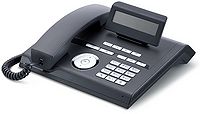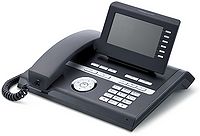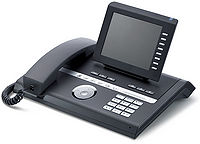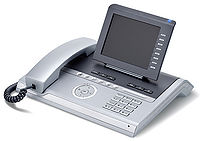Difference between revisions of "OpenStage T"
The Wiki of Unify contains information on clients and devices, communications systems and unified communications. - Unify GmbH & Co. KG is a Trademark Licensee of Siemens AG.
m (→Current software releases: Some corrections) |
|||
| Line 8: | Line 8: | ||
| valign="bottom" class="noborder" | [[Image:os40-p.jpg|200px]] | | valign="bottom" class="noborder" | [[Image:os40-p.jpg|200px]] | ||
|- | |- | ||
| − | | class="noborder" | OpenStage 20 | + | | class="noborder" | OpenStage 20 T |
| − | | class="noborder" | OpenStage 40 | + | | class="noborder" | OpenStage 40 T |
| + | |- | ||
| + | | valign="bottom" class="noborder" | [[Image:os60-p.jpg|200px]] | ||
| + | | valign="bottom" class="noborder" | [[Image:os80t-p.jpg|200px]] | ||
| + | |- | ||
| + | | class="noborder" | OpenStage 60 T | ||
| + | | class="noborder" | OpenStage 80 T | ||
|} | |} | ||
| Line 38: | Line 44: | ||
! width=120px|OpenStage 20 | ! width=120px|OpenStage 20 | ||
! width=120px|OpenStage 40 | ! width=120px|OpenStage 40 | ||
| − | + | ! width=150px|OpenStage 60 | |
| − | ! width=150px|OpenStage 80 | + | ! width=150px|OpenStage 80 |
|- | |- | ||
| Technology | | Technology | ||
| [[LCD]] | | [[LCD]] | ||
| [[LCD]] | | [[LCD]] | ||
| − | + | | [[TFT]] | |
| − | | [[TFT]] | + | | [[TFT]] |
|- | |- | ||
| Color | | Color | ||
| Monochrome | | Monochrome | ||
| Monochrome | | Monochrome | ||
| − | + | | 16 bit depth | |
| − | | 16 bit depth | + | | 16 bit depth |
|- | |- | ||
| Size | | Size | ||
| 205x41 pixel | | 205x41 pixel | ||
| 240x128 pixel | | 240x128 pixel | ||
| − | + | | 320x240 pixel ([[QVGA]]) | |
| − | | | + | | 320x240 pixel ([[QVGA]]) |
|- | |- | ||
| Diagonal | | Diagonal | ||
| N/A | | N/A | ||
| 5.1" | | 5.1" | ||
| − | + | | 5.7" | |
| − | | | + | | 5.7" |
|- | |- | ||
| Lines | | Lines | ||
| 2 (24 characters) | | 2 (24 characters) | ||
| 6 (Graphics) | | 6 (Graphics) | ||
| − | + | | Graphics | |
| − | | Graphics | + | | Graphics |
|- | |- | ||
| Backlit | | Backlit | ||
| No | | No | ||
| Yes | | Yes | ||
| − | + | | Yes | |
| − | | Yes | + | | Yes |
|} | |} | ||
| Line 84: | Line 90: | ||
! width=150px|OpenStage 20 | ! width=150px|OpenStage 20 | ||
! width=150px|OpenStage 40 | ! width=150px|OpenStage 40 | ||
| − | + | ! width=150px|OpenStage 60 | |
| − | ! width=150px|OpenStage 80 | + | ! width=150px|OpenStage 80 |
|- | |- | ||
| Fixed function keys (Pushbuttons) | | Fixed function keys (Pushbuttons) | ||
| 7 (5 red [[LED]]s)<ref name="Pushbuttons_note">No [[LED]] for call ''Drop''/''Release'' or ''Redial''.<br \></ref> | | 7 (5 red [[LED]]s)<ref name="Pushbuttons_note">No [[LED]] for call ''Drop''/''Release'' or ''Redial''.<br \></ref> | ||
| 8 (6 red [[LED]]s)<ref name="Pushbuttons_note" /> | | 8 (6 red [[LED]]s)<ref name="Pushbuttons_note" /> | ||
| − | + | | 6 (5 blue [[LED]]s)<ref name="Pushbuttons_note" /> | |
| − | | 6 (5 blue [[LED]]s)<ref name="Pushbuttons_note" / | + | | 6 (5 blue [[LED]]s)<ref name="Pushbuttons_note" /> |
|- | |- | ||
| Freely programmable touch keys | | Freely programmable touch keys | ||
| 0 | | 0 | ||
| 6 (red [[LED]]s)<ref name="Touch_Keys_note">Thereof one can be a Shift Key 2 levels.<br \></ref> | | 6 (red [[LED]]s)<ref name="Touch_Keys_note">Thereof one can be a Shift Key 2 levels.<br \></ref> | ||
| − | + | | 8 (blue [[LED]]s)<ref name="Touch_Keys_note" /> | |
| − | | | + | | 8 (blue [[LED]]s)<ref name="Touch_Keys_note" /> |
|- | |- | ||
| Mode keys (touch keys) | | Mode keys (touch keys) | ||
| 0 | | 0 | ||
| 0 | | 0 | ||
| − | + | | 6 (blue [[LED]]s)<ref name="Mode_Keys_note">Thereof 2 (''Call Log'' and ''Message Waiting'') with additional white [[LED]] to display status changes.<br \></ref> | |
| − | | 6 (blue [[LED]]s)<ref name="Mode_Keys_note" / | + | | 6 (blue [[LED]]s)<ref name="Mode_Keys_note" /> |
|- | |- | ||
| Optical call alert | | Optical call alert | ||
| No | | No | ||
| Red [[LED]] | | Red [[LED]] | ||
| − | + | | Blue [[LED]] | |
| − | | Blue [[LED]] | + | | Blue [[LED]] |
|- | |- | ||
| Volume adjustment | | Volume adjustment | ||
| via +/- keys | | via +/- keys | ||
| via +/- keys | | via +/- keys | ||
| − | + | | via [[TouchSlider]]<ref name="Volume_adjustment_note">With blue/white LEDs.<br \></ref> | |
| − | | via [[TouchSlider]]<ref name="Volume_adjustment_note" / | + | | via [[TouchSlider]]<ref name="Volume_adjustment_note" /> |
|- | |- | ||
| Navigation element | | Navigation element | ||
| [[OpenStage Main Navigation|3 Ways navigator]] | | [[OpenStage Main Navigation|3 Ways navigator]] | ||
| [[OpenStage Main Navigation|5 Ways navigator]] | | [[OpenStage Main Navigation|5 Ways navigator]] | ||
| − | + | | [[TouchGuide]] | |
| − | | [[TouchGuide]] | + | | [[TouchGuide]] |
|} | |} | ||
<references /> | <references /> | ||
| Line 131: | Line 137: | ||
! width=100px | OpenStage 20 | ! width=100px | OpenStage 20 | ||
! width=100px | OpenStage 40 | ! width=100px | OpenStage 40 | ||
| − | + | ! width=100px | OpenStage 60 | |
| − | ! width=100px | OpenStage 80 | + | ! width=100px | OpenStage 80 |
| − | + | |- | |
| style="text-align:left" | [[OpenStage Bluetooth|Bluetooth V2.0]] | | style="text-align:left" | [[OpenStage Bluetooth|Bluetooth V2.0]] | ||
| No | | No | ||
| No | | No | ||
| [[Image:tick.gif]] | | [[Image:tick.gif]] | ||
| − | | [[Image:tick.gif]] | + | | [[Image:tick.gif]] |
|- | |- | ||
| style="text-align:left" | Headset jack (121 TR9-5) | | style="text-align:left" | Headset jack (121 TR9-5) | ||
| No | | No | ||
| [[Image:tick.gif]] | | [[Image:tick.gif]] | ||
| − | + | | [[Image:tick.gif]] | |
| − | | [[Image:tick.gif]] | + | | [[Image:tick.gif]] |
|- | |- | ||
| style="text-align:left" | USB Master | | style="text-align:left" | USB Master | ||
| No | | No | ||
| No | | No | ||
| − | + | | [[Image:tick.gif]] | |
| − | | [[Image:tick.gif]] | + | | [[Image:tick.gif]] |
|- | |- | ||
| style="text-align:left" | USB Slave | | style="text-align:left" | USB Slave | ||
| No | | No | ||
| [[Image:tick.gif]] | | [[Image:tick.gif]] | ||
| − | + | | [[Image:tick.gif]] | |
| − | | [[Image:tick.gif]] | + | | [[Image:tick.gif]] |
|} | |} | ||
| Line 187: | Line 193: | ||
== Firmware / Software == | == Firmware / Software == | ||
| − | |||
=== Current software releases === | === Current software releases === | ||
| Line 267: | Line 272: | ||
{{SeeAlso OpenStage}} | {{SeeAlso OpenStage}} | ||
| − | |||
[[Category:OpenStage]] | [[Category:OpenStage]] | ||
[[Category:Device]] | [[Category:Device]] | ||
Revision as of 08:20, 6 May 2008

|

|
| OpenStage 20 T | OpenStage 40 T |

|

|
| OpenStage 60 T | OpenStage 80 T |
The OpenStage phone family currently consists of the both UP0/E phones OpenStage 20 T and OpenStage 40 T.
Contents
Phone range
Common features
The OpenStage family have a wide common feature set (listed below) and additional features per model (specified for each phone model).
- Full-duplex hands-free talking
- Tiltable display
- Built-in applications:
- Graphical call handling
- Local Telephone book
- Call log / history
- Help
- Free programmable sensorkeys (OpenStage 40 T)
- Keypad with 12 keys
- Increasing combination of various housing colors and materials from model to model (ice blue, lava)
Differentiating factors
Display
| Tiltable Display | OpenStage 20 | OpenStage 40 | OpenStage 60 | OpenStage 80 |
|---|---|---|---|---|
| Technology | LCD | LCD | TFT | TFT |
| Color | Monochrome | Monochrome | 16 bit depth | 16 bit depth |
| Size | 205x41 pixel | 240x128 pixel | 320x240 pixel (QVGA) | 320x240 pixel (QVGA) |
| Diagonal | N/A | 5.1" | 5.7" | 5.7" |
| Lines | 2 (24 characters) | 6 (Graphics) | Graphics | Graphics |
| Backlit | No | Yes | Yes | Yes |
Keys/LEDs
| Keys and LEDs features | OpenStage 20 | OpenStage 40 | OpenStage 60 | OpenStage 80 |
|---|---|---|---|---|
| Fixed function keys (Pushbuttons) | 7 (5 red LEDs)[1] | 8 (6 red LEDs)[1] | 6 (5 blue LEDs)[1] | 6 (5 blue LEDs)[1] |
| Freely programmable touch keys | 0 | 6 (red LEDs)[2] | 8 (blue LEDs)[2] | 8 (blue LEDs)[2] |
| Mode keys (touch keys) | 0 | 0 | 6 (blue LEDs)[3] | 6 (blue LEDs)[3] |
| Optical call alert | No | Red LED | Blue LED | Blue LED |
| Volume adjustment | via +/- keys | via +/- keys | via TouchSlider[4] | via TouchSlider[4] |
| Navigation element | 3 Ways navigator | 5 Ways navigator | TouchGuide | TouchGuide |
Interfaces
| Interfaces | OpenStage 20 | OpenStage 40 | OpenStage 60 | OpenStage 80 |
|---|---|---|---|---|
| Bluetooth V2.0 | No | No | |
|
| Headset jack (121 TR9-5) | No | |
|
|
| USB Master | No | No | |
|
| USB Slave | No | |
|
|
Documentation
All OpenStage phones are shipped with a printed document (![]() QRG OpenStage ML) providing brief instruction regarding installation and operation.
QRG OpenStage ML) providing brief instruction regarding installation and operation.
|
 English
English
-
 Datasheet OpenStage T
Datasheet OpenStage T -
 Quick Reference Guide OpenStage 20 HFA-TDM
Quick Reference Guide OpenStage 20 HFA-TDM -
 Quick Reference Guide OpenStage 40 HFA-TDM
Quick Reference Guide OpenStage 40 HFA-TDM -
 Quick Reference Guide OpenStage 60-80 HFA-TDM
Quick Reference Guide OpenStage 60-80 HFA-TDM -
 User Manual OpenStage 20 T HP3000-HP5000
User Manual OpenStage 20 T HP3000-HP5000 -
 User Manual OpenStage 40 T HP3000-HP5000
User Manual OpenStage 40 T HP3000-HP5000 -
 User Manual OpenStage 60-80 T HP3000-HP5000
User Manual OpenStage 60-80 T HP3000-HP5000
 Deutsch
Deutsch
-
 Datenblatt OpenStage T
Datenblatt OpenStage T -
 Kurzanleitung OpenStage 20 HFA-TDM
Kurzanleitung OpenStage 20 HFA-TDM -
 Kurzanleitung OpenStage 40 HFA-TDM
Kurzanleitung OpenStage 40 HFA-TDM -
 Kurzanleitung OpenStage 60-80 HFA-TDM
Kurzanleitung OpenStage 60-80 HFA-TDM -
 Bedienungsanleitung OpenStage 20 T HP3000-HP5000
Bedienungsanleitung OpenStage 20 T HP3000-HP5000 -
 Bedienungsanleitung OpenStage 40 T HP3000-HP5000
Bedienungsanleitung OpenStage 40 T HP3000-HP5000 -
 Bedienungsanleitung OpenStage 60-80 T HP3000-HP5000
Bedienungsanleitung OpenStage 60-80 T HP3000-HP5000
Firmware / Software
Current software releases
The OpenStage T Application software versions actually available are:
- OpenStage 20 T V1 R0.12.0
- OpenStage 40 T V1 R0.14.0
- OpenStage 60 T V1 R0.1.0 (released for use with HiPath 3000 V7 R4.1.023)
- OpenStage 80 T V1 R0.1.0 (released for use with HiPath 3000 V7 R4.1.023)
| Version | Release | Release date | Release note | Notes |
|---|---|---|---|---|
| V1 | R0.1.0 | 25/04/2008 | OpenStage T V1 R0.1.0 | OpenStage 60/80 |
| V1 | R0.14.0 | 03/04/2008 | OpenStage T V1 R0.14.0 | OpenStage 40 only |
| V1 | R0.12.0 | 30/01/2008 | OpenStage T V1 R0.12.0 | OpenStage 20/40 |
| V1 | R0.11.0 | 03/12/2007 | OpenStage T V1 R0.11.0 | OpenStage 40 only |
| V1 | R0.8.0 | 28/09/2007 | OpenStage T V1 R0.8.0 | OpenStage 20/40 |
| V1 | R0.7.0 | 31/08/2007 | OpenStage T V1 R0.7.0 | OpenStage 20/40 |
| V1 | R0.5.0 | 28/06/2007 | OpenStage T V1 R0.5.0 | OpenStage 20/40 |
To get an overview of all release notes for the OpenStage T family see the history of all Release Notes.
Interoperability Matrix
For detailed interoperability information please check OpenStage T interoperability matrix.
Add-On devices, Adapters and Accessories
External links
- You can visit the OpenStage Tour from the SIEMENS Enterprise web site.
- You can read the SIEMENS Open Communications News Press Release (December 2006) about the released OpenStage family of SIP phones.
- You can have a look to the whole SIP terminal devices families on www.siemens.com/enterprise web site.
- Siemens won the iF product design award 2007 for its OpenStage phone, OpenStage was awarded at iF awards ceremony of iF product design award 2007 during CeBIT fair last 15.03.2007 in Hannover.
See also
- OpenStage - the portal page of the OpenStage telephone family
- OpenStage Training - easy learning to use your feature-rich enterprise phone
- OpenStage Manager - feature description of the PC application for OpenStage
- OpenStage power supply and PoE classes - required power supply and PoE classes of phones and accessories
- OpenStage Hardware Changes and necessary Software Versions - comparative table of supported hardware versions
- OpenStage Bluetooth - OpenStage 60/80 Bluetooth feature information
- OpenStage Accessories - Add-On devices, Adapters and Accessories
- OpenStage Main Navigation - comparative information about the main navigation elements




